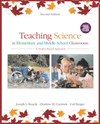 |  Teaching Children Science: A Project-Based Approach, 2/e Joe Krajcik,
University of Michigan - Ann Arbor
Charlene Czerniak,
University of Toledo
Carl Berger,
University of Michigan - Ann Arbor
Why Do We Assess Students in Science?
Chapter Summary- Assessment is any method used to judge or evaluate an outcome or help make a decision.
- Assessment data are used for a variety of purposes in educational settings today:
- Assisted learning.
- Guiding teaching.
- Measuring individual achievement.
- Giving grades.
- Allocating resources.
- Evaluating programs.
- Informing local, state, and national policy.
- Research shows that regular, high-quality assessment can have a positive effect on student achievement.
- Large-scale assessments are used to evaluate students' achievement, school curriculum, school district progress, and programs.
- Many educators argue that large-scale assessments are only one-shot methods and may not measure what is taught in a local school's curriculum.
- Some educational leaders view large-scale assessments as insufficient for meeting the assessment standards found in the National Science Education Standards.
- Assessment appropriate for today's science classrooms has several features:
- It is responsive to context.
- It is a continuous process embedded in instruction.
- It is multidimensional.
- It engages students in the assessment process.
- It is valid and reliable.
- It matches today's educational goals.
- It accommodates cultural diversity.
- It is consistent with cognitive learning theory.
- It measures meaningful understanding.
- Assessments measure science content, science process, and understandings about inquiry.
- Assessment also monitors the affective side of learning.
- The cognitive process domain can be used as a framework to assess student understanding.
- Formative assessment helps teachers evaluate students' progress during a unit of study and make day-to-day decisions regarding curriculum and instruction.
- Effective formative assessment has a framework to three guiding questions:
- Where are you trying to go?
- Where are you now?
- How can you get there?
- Summative assessment occurs at the end of a unit of instruction or time period to determine achievement, issue grades, promote students, or demonstrate accountability.
- Both formative and summative assessments can inform classroom practices and help students learn.
- Technology tools can help teachers become part of a community of learners who are interested in improving assessment practices.
|
|



 2003 McGraw-Hill Higher Education
2003 McGraw-Hill Higher Education